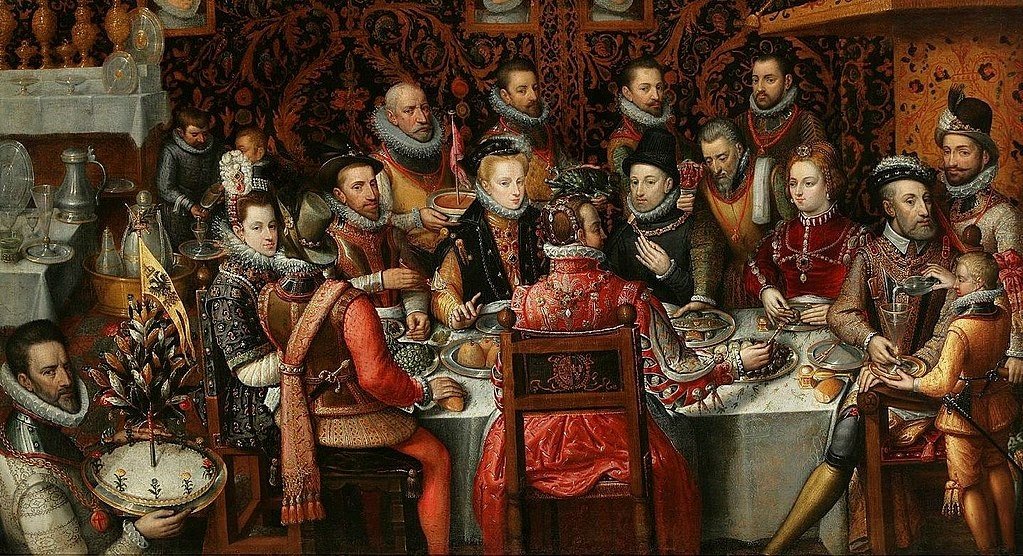A Tudor Christmas
Tudor Feast by Alonso Sánchez Coello [Public domain]
A Tudor Christmas
As we get ready for Christmas with tinsel, plastic decorations, Christmas trees, Santa Claus, elves, and flying reindeer, it is easy to imagine that this ancient celebration has always been similar. But the winter festival of Tudor Britain was a very different event.
Firstly, was a religious event but did not hold the significance it does today. Christmas day would start with mass – but most people saw the festival as one of celebration. In four days’ time – December 25th you would be entering the twelve days of Christmas we now celebrate in a carol. It was a time of merriment and gathering of friends and clans – and much enjoyed after the four weeks of fasting required during the Advent period which would have started November 25th. It was a period of rest with even women’s work of spinning banned and flowers placed on spinning wheels as reminders. Ploughs rested. Farm animals stood in barns.
By now, the young men of your household would have been out in the woods to choose the yule log – not a chocolate cake as today, but the bough of a tree which they will chop down on Christmas Eve, decorate with ribbons and then drag into the house to light and keep lit for the twelve days. If you were superstitious – as most were – you would light your yule with a blacked stick of last year’s log for good luck.
Your home would likely be decorated with holly, oak, laurel, and any other evergreen you could find in the abundant local woods. But no mistletoe – the kiss-inviting bunch was not a feature of Christmas for nearly another century. Though you may have created a kissing bough – a hoop of willow decorated with evergreen and ribbon, much like our Christmas wreath under which old friends were meant to meet and embrace. There would be no Christmas tree – they did not appear until the Court of Victoria nearly 300 years later. As for presents – you could forget those until New Year’s Day.
If you were in Court, in a wealthy home or the Inns of Court, you had already appointed the Lord of Misrule – a medieval party planner – responsible for all the revelry, drinking, gambling, processions, masques, plays, and feasting which would fill the twelve days. His final task was to ensure that the feast on Twelfth Night was one to be remembered.
After the long fast, food was part of the celebration. If you were poor, you probably made do with an umble pie (a pie of minced deer offal) or maybe a small amount of meat. But, as today, the rich saw the festivities as a time to indulge their every gastro-whim. Turkeys were getting popular after being introduced in the 1520’s and approved as Christmas fayre by Henry viii, but more likely you would be tucking into the spiced head of wild boar, brawn, beef, tongue, swan, pheasant, venison, and anything else which could be roasted on a spit. After platters of meat would be marchpane – now called marzipan – spiced fruits, candied fruits, nuts, and cakes. Mynce pies were a nod to the nativity being made of thirteen ingredients including lamb and spices to represent Christ and the twelve disciples. They were also rectangular to represent the nativity crib.
As for drinks, the wassail bowl – a tub of hot cider, apples, spices, and a slice of bread at the bottom was common to all households. Everyone dipped their mugs, drank deep and, when they reached the bread, it was presented to the most prestigious person in the room. Maybe the forerunner of ‘toasting’.
But very similar to today was the huge divide between rich and poor. Those below merchant class would go to mass and return to a meal of bread, meat if lucky, a wassail pot, and then beer. The middle ranking, like John Dee and Margaretta, would enjoy roast meat, wine, and some spiced fruits. The rich would be gorging on every food they could imagine, spiced with exotic flavours costing the same as gold. Wine would flow, pageants blare, dancers whirl, and money slip through gamblers’ fingers. Some would salve their conscience and give spare food and some alms to the poor, but for most, it was time to indulge.
Further reading
A Tudor Christmas. Alison Weir and Siobhan Clarke [ISBN: 9781787330641 Jonathan Cape, 2018
